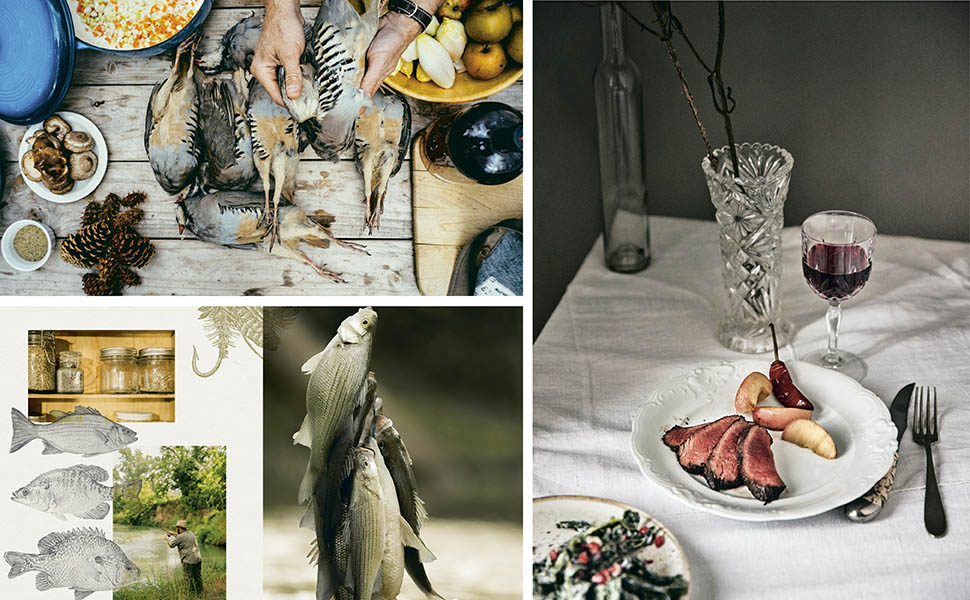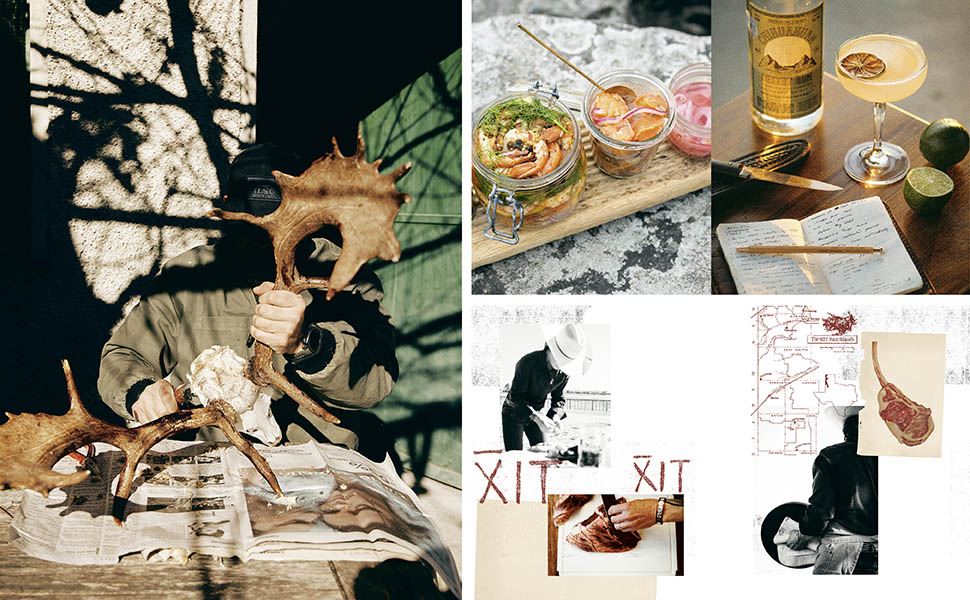A Way of Life
Jamie Harrison
I live in Montana, where more than half the population consider themselves hunters or anglers, the only state besides Wyoming where this is true. My family is average: We have a drift boat, though we don’t get onto the Yellowstone as much as we’d like; we have venison and birds and some wild-caught fish in the freezer. Two shotguns, two rifles, several rods, huge quantities of flies. My husband always puts in for game licenses but usually settles for a whitetail or an antelope every year, not both. He’s there for the clean shot, the well-handled carcass, the meat, as compared to the hunters with salt licks and carrot dumps of his Michigan youth. Here, if you know someone who will give you access, you can drive for half an hour and return within three or four with a gutted carcass. Hang, skin, wash up—short on bravado, big on delivery. Though my husband, who moved here with me thirty-seven years ago, always hunts with friends, and though the landscape is always beautiful, he’s mostly hunting deer for the sake of food. Fishing may be a passion, but hunting is appetite. The state’s large population of hunters might come down to the fact that we still have wild places to hunt in, but a relatively high percentage of this state truly does rely on game for food.
I have never hunted. I will skin your rabbit, pluck and draw your quail or grouse or woodcock, trim your antelope heart, bone your whitetail haunch or your fish, and I’ve worked hard to find the best ways to cook all of it. I’ve never been able to kill more than a chicken or a garden-raiding squirrel, but I’ll fry slices of still-warm heart without a qualm.
My husband and I like to cook, and we come from families of good cooks. Our behavior verges on the extreme: so many cookbooks, so many odd ingredients in the pantry and in the garden. Some of this behavior is due to our backgrounds and former professions—I worked in food before we moved here—and some is selfdefense. We love to eat, and when we moved here from New York, the pickings were slim in the grocery stores, and we lacked the money to eat out in the few restaurants in town. And so the two freezers, the bins of curry ingredients and chiles, pasta and polenta, black vinegar and fish sauce and fermented bean pastes feed us. The freezers are packed with garden stuff, and we buy a lamb and half a pig annually, but most of the space usually goes to deer and antelope, elk and birds, and salmon from friends in Alaska.
And we make all sorts of stuff with this plenty: khao soi with venison (drop the scallops of meat into the curry, then take the pan off the burner to avoid overcooking), elk shank posole (both green with roasted green chiles from Colorado and red with the soft dried ancho and morita chiles a son sends from Central Market in LA), whitetail fajitas, a little trout pie with cream and mushrooms and chard, ragus, salmon with fresh coriander seed and a preserved lemon and picholine olive confit. Dry-fried elk with fresh-batch Sichuan peppercorns, red chiles, and long-cooked matchsticks of ginger, carrot, and celery, served with a cooling but incendiary cucumber salad, studded with chiles; steamed Chinese buns and dumplings with ground game, served with homemade chile oil. Also with ground game, often with pork or lamb added for fat: Bolognese sauces, antelope laab, tacos, and picadillo. For meatballs, I almost always add a little anchovy melted in with whatever allium and whatever herb, whether the recipe is: Thai with fresh lime leaves, Spanish with sherry and saffron, German with capers and lemon, Italian with pancetta and chile flakes, or Middle Eastern with preserved lemon and sumac. Meatloaf with a thin brown shell of caramelized onions and garden tomatoes, moussaka, shepherd’s pie, kormas and vindaloos and kebabs. Liver seared with onions and apples; thin slices of heart fried with fresh sage leaves. Rabbit with mustard sauce, rabbit with prunes. Venison carbonnades, grilled loin with a béarnaise, grilled loin with chimichurri and smoked Hatch chiles. Grilled quail, grilled doves, crappies from an ice-fishing friend, triggerfish and snapper and grouper from a Florida care package, chowders. From friends: lamb and game potstickers, and elk seared and served with a soy wasabi butter, and the best tamales ever, with elk shoulder.
Half of what we have goes to others who can’t get it—they’re in a city, they’re older, they don’t hunt. A friend—a lunatic remembered fondly—once took venison to Istanbul and Azerbaijan. We’ve sent packets for years to my mother-in-law and a haunch to a New York restaurateur who performed many acts of kindness. We keep freezer packs on hand and send visitors home with heavy luggage, hoping nothing ends up at the wrong airport.
Game is precious. Wasting food is bad anywhere and anytime, but wasting game feels like a true sin. If you’re going to kill something, if you’re going to look into its eyes, you better treat it right.
I was born in Michigan, in a time and place where hunting and eating game were the norm, as they still are in Montana. My father, the writer Jim Harrison, grew up hunting and fishing, and wrote about these topics—and about food—throughout his life. My maternal grandparents were also very good cooks, and my grandfather cooked game well: moist, boozy roast pheasant; pink venison roasts; wild duck, just barely done (which sounds like a contemporary preparation but which the Joy of Cooking mandated: 450°F, less than 20 minutes). Up at his Clear Lake cottage, where the shore was covered with wild blueberries, we’d row out for bluegills, which he’d fry in butter.
My parents moved back and forth between the city and the country when I was a kid, between Michigan and Boston and Long Island, and my early food memories are a confusion of different worlds: feathers and seafood markets, first Chinese meals and picking thimbleberries. In Kingsley, Michigan, where my father worked as a bricklayer, a friend named Vesper Paton would cover a platter with slice after slice of perfectly sautéed venison while she chain-smoked and laughed with my mother at whatever bullshit stories their husbands were telling. On the East Coast, in Stony Brook, New York, I lived on fried scallops and performed early food experiments: Would the crazed English pointer eat mussels? (No.) Could you cook and eat jellyfish, like squid? (No.) Would the three clams you managed to pry out with fat small hands taste good raw? (Yes.)
When we landed back in Northern Michigan, on the Leelanau Peninsula, the house we rented was surrounded by orchards, and the surrounding fruit—peaches, plums, apples, grapes, apricots, cherries, raspberries—became part of the idyll. My father went back to hunting, and I gorged in trees. We lived by a small fishing port and ate whitefish and lake trout or smoked chubs once or twice a week. Fishing doesn’t feel commercial when you know the people doing it. In the spring, we’d drive five miles to Lake Michigan for smelt runs, with big fry pans for the tiny fish and for sizzling asparagus in butter, and in the summer, we’d have beach parties with game sausages and freshgigged frog’s legs, fried in more butter. Blackberries, wild strawberries, fiddleheads, ramps, bottle after bottle of Gallo wine.
We had very little money, but we ate well. This did not seem to be the norm. Other people’s venison stew bounced or bubbled in gray slime, and I discovered that the TV dinners I’d longed for were tragically disappointing. Other people, similarly, didn’t seem to know how to hunt, or care about doing it well. I grew up wary of downstate assholes like the men who chased a wounded whitetail into our yard, shots ricocheting around while I hid in the barn and the horses panicked. They left the mortally wounded deer to die in the woods.
Bad aim, bad worldview, bad whiskey.
Late in his life, my father moved away from hunting large game. He simply did not want to kill something with a heart as large as his own, something that looked back at him with eyes as big as his own. Fishing and bird hunting took over, and it changed the way we lived. In the spring of 1970, he flew down to Key West to visit one old friend and met another: Guy de la Valdène, a French count who’d grown up bonefishing.
The bacchanal was on. There are no typical childhoods, but in a confluence of personalities and the spirit of the age, a feeding frenzy was about to begin. For the next thirty years, the month of October was given over to eating and hunting, often with the painter and fisherman Russell Chatham.
This is how I learned to cook, and how everyone else became better cooks: every night, all of us in the kitchen, with my little sister sitting on the counter, offering advice. Friends who moved to Michigan from Perth brought Elizabeth David’s books, and by about 1974, we had Marcella Hazan and Ada Boni,
Mrs. Chang’s Szechwan Cookbook and
Henry Chung’s Hunan Style Cookbook, the big brown
Gourmet books, Raymond Oliver. Russell would fly in from California with shad roe or abalone, Guy would arrive in a van with wine and foie gras and dogs, and for three weeks we would cook and drink every night after they hunted. Not just the first attempts at
salmis de bécasse, a rich woodcock classic and ruffed grouse with grapes, but homemade ravioli and spring rolls and Chinese dumplings. Steamed whitefish with fresh ginger, cacciatore with wild rabbit and garden tomatoes and dried morels, tiny venison involtini. Beautiful pâtés, one of which—en croûte—was stolen by the dogs.
Copyright © 2025 by The Editors of Modern Huntsman Magazine. All rights reserved. No part of this excerpt may be reproduced or reprinted without permission in writing from the publisher.


















